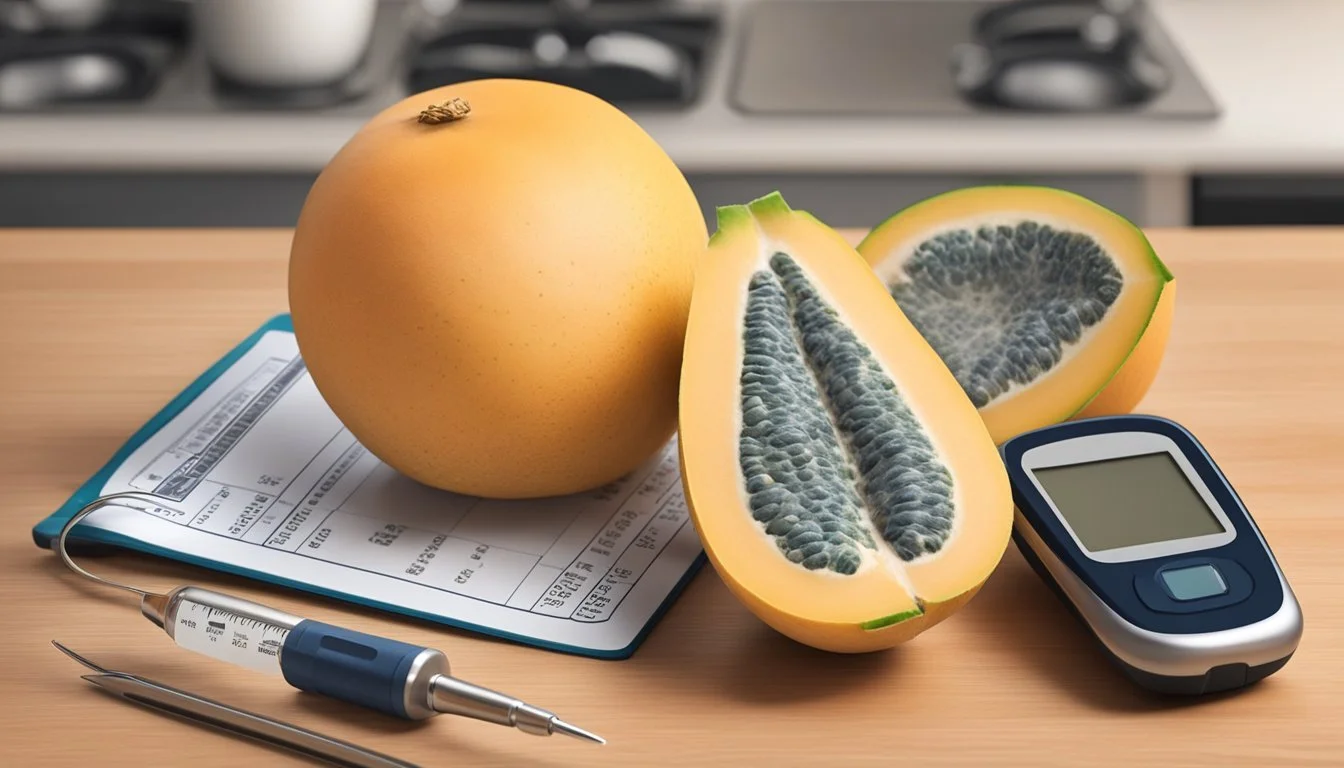Can Diabetics Eat Cantaloupe?
Understanding the Fruit's Glycemic Impact
Individuals with diabetes must carefully manage their dietary intake to maintain stable blood sugar levels, often leading to questions about which foods are safe to eat. Fruit, though a healthy part of one's diet, can be a source of concern due to its sugar content. Cantaloupe is a particular fruit that often comes under scrutiny in diabetes meal planning. It is rich in essential nutrients, including vitamins A and C, and provides both soluble and insoluble fiber, which can be beneficial for maintaining a healthy weight.
While it is true that cantaloupe contains natural sugars, its impact on blood sugar can be less significant because it has a lower glycemic index compared to many other fruits (What wine goes well with fruits?). This means that cantaloupe can be part of a diabetes meal plan when consumed in controlled portions. The key is to monitor the fruit's contribution to the day's total carbohydrate intake, as this is what most directly affects blood sugar levels.
Managing diabetes does not necessarily mean one has to forgo the pleasure of eating fruit. Incorporating cantaloupe into a balanced diet can be valuable for diabetics seeking variety and nutritional density in their meals. It is important to consider individual dietary needs and consult with healthcare providers to determine the best approach for including cantaloupe and other fruits into a meal plan that supports diabetes management.
Nutritional Profile of Cantaloupe
Cantaloupe, a hydrating fruit with a sweet, musky aroma, offers a range of nutrients in its flesh. Understanding its nutritional profile can aid individuals, including diabetics, in making informed dietary choices.
Vitamins and Minerals Content
Cantaloupe is an excellent source of vitamin A and vitamin C, two antioxidants that are essential for maintaining healthy skin and immune system function. It also contains a good balance of essential minerals, including:
Potassium: Important for blood pressure control and cardiovascular health.
Magnesium: Involved in over 300 biochemical reactions in the body.
Calcium: Crucial for bone health.
Iron: Essential for red blood cell formation.
Small amounts of manganese, copper, and selenium.
Macronutrients: Carbs, Fiber, and Protein
The macronutrients of cantaloupe are primarily carbohydrates, with a modest amount of fiber and protein. Here's a breakdown:
Carbohydrates: The primary source of energy in cantaloupe, mainly consisting of natural sugars.
Fiber: Aids in digestion and can help in managing blood sugar levels.
Protein: Present in small quantities; not a significant source of protein.
Caloric Value and Portion Sizes
A standard serving size of cantaloupe is typically one cup of diced fruit. In this portion size, cantaloupe offers approximately:
60 calories, making it a low-calorie option for a nutritious snack.
Portion control is key, especially for individuals monitoring their blood sugar levels, as consuming it in moderation can ensure that they enjoy the benefits of the fruit without adversely affecting their glycemic control.
Health Benefits of Cantaloupe
Cantaloupe is a nutrient-rich fruit that provides a variety of health benefits, particularly for hydration, antioxidants, immune system support, heart health, and eye health.
Hydration and Water Content
Cantaloupe has a high water content, making it an excellent choice for maintaining hydration. This melon is composed of about 90% water, which can help keep the body hydrated, especially during hot weather or after exercise.
Antioxidant Properties
This fruit is a source of powerful antioxidants, such as beta-carotene, which helps to neutralize free radicals in the body. By reducing inflammation and oxidative stress, these antioxidants may reduce the risk of various chronic diseases.
Support for the Immune System
Rich in vitamin A and vitamin C, cantaloupe aids in bolstering the immune system. Vitamin A is essential for maintaining mucous membranes, while vitamin C is known for its immune-boosting effects.
Impact on Heart Health
Cantaloupe contains potassium, a nutrient that can help control blood pressure, and cholesterol levels, reducing the risk of heart disease. The fiber content also plays a role in heart health by assisting in the management of cholesterol.
Benefits for Eye Health
In terms of eye health, cantaloupe's high levels of beta-carotene convert to vitamin A in the body which is vital for protecting vision and maintaining healthy eyes.
The Glycemic Index of Cantaloupe
The glycemic index (GI) of cantaloupe is rated at 64, placing it in the moderate range, while its glycemic load (GL) stands at a lower value, indicative of its impact on blood sugar levels when consumed in average quantities.
Understanding Glycemic Index and Load
Glycemic Index is a scale from 0 to 100 that measures how much a carbohydrate-containing food increases blood glucose levels. Glycemic Load, on the other hand, takes into account the serving size of the food, providing a more practical measure of its impact on blood sugar.
Low GI: 55 or less
Medium GI: 56 to 69
High GI: 70 or higher
Cantaloupe's glycemic index of 64 categorizes it as a medium GI fruit. When considering glycemic load, which is a combination of the GI and the actual carbohydrate content in a typical serving, cantaloupe has a low GL of 4, suggesting that it can be incorporated in moderation into a diabetic diet without significantly impacting blood sugar levels.
Comparing Melons and Other Fruits
When comparing cantaloupe to other fruits, particularly in regards to their glycemic index and load, it's important to consider variety:
Watermelon: High GI (72) with moderate GL
Berries: Low GI; for example, strawberries and blueberries have a GI less than 55
Apples: Low GI (38)
Mango: Medium GI (56 to 59)
Pineapple: Medium GI (59)
Bananas: Variable GI depending on ripeness, with overly ripe bananas having a higher GI
Diabetics may opt for fruits with lower glycemic indexes, such as berries and apples, but can also enjoy cantaloupe and mango in moderation, mindful of portion sizes and overall carbohydrate intake to maintain stable blood sugar levels.
Cantaloupe in Diabetic Diets
Cantaloupe can be part of a balanced meal plan for individuals with diabetes, offering a way to satisfy a sweet tooth while managing blood sugar levels. The key lies in how it's incorporated into the diet and the quantities consumed.
Incorporating Cantaloupe into Meals
When integrating cantaloupe into a diabetic meal plan, one should consider the fruit's glycemic impact. Cantaloupe can be added to fruit salads or eaten as a snack, preferably along with foods high in fiber or protein to reduce the overall glycemic load. Mixing cantaloupe with lower glycemic index fruits such as berries, apples, and pears, or adding it to a salad with vegetables and nuts, can create a nutritious and satisfying meal.
Portion Control and Serving Size
For individuals with type 2 diabetes, portion control is critical to maintaining healthy blood sugar levels. A typical serving size of cantaloupe for a diabetic might be:
1/2 cup diced cantaloupe (approximately 78 grams)
Monitoring blood glucose responses to varying amounts of cantaloupe can help diabetics understand how their bodies react to the fruit and adjust their serving sizes accordingly.
Alternative Fruit Options
Diabetics seeking variety in their diets can explore other fruits that have a low to moderate impact on blood sugar. Alternatives include:
Berries like strawberries, blackberries, and raspberries, which are high in fiber and lower in sugar.
Citrus fruits such as oranges and kiwi, known for their vitamin C content.
Mangoes, papaya, and pears, which should be consumed in moderation due to higher sugar content.
Each fruit can be assessed for its nutritional value and incorporated into a meal plan to provide a balance of taste and health benefits.
Risks and Considerations
When incorporating cantaloupe into a diabetic diet, it is crucial for individuals to consider both the sugar content and potential allergens to manage their blood sugar levels effectively and avoid adverse reactions.
Sugar Content and Diabetes Management
Cantaloupe has a low glycemic index, which implies it is less likely to cause rapid spikes in blood sugar levels. However, it does contain fructose, a type of sugar, which can impact blood sugar control if consumed in large quantities. For diabetics, monitoring the portion of cantaloupe consumed is essential to maintain optimal blood sugar levels. Balancing cantaloupe intake with other meals throughout the day ensures a steady supply of glucose to the body without overwhelming it with a surge that could necessitate more insulin.
Potential Allergens and Interactions
Although allergies to cantaloupe are not common, individuals can have specific sensitivities to fruits that contain potassium and fructose. Those with a known fructose intolerance should approach cantaloupe consumption cautiously. Moreover, for those managing diabetes-related kidney issues and on potassium-restricted diets, it is important to monitor the intake of cantaloupe due to its potassium content. Interactions with medication, particularly those affecting insulin and blood sugar levels, should be considered; diabetics are advised to consult with healthcare professionals regarding their diet to safely incorporate cantaloupe.
Practical Tips for Enjoying Cantaloupe
Cantaloupe can be a nourishing choice for individuals managing diabetes, mainly due to its fiber content and sweet yet low-glycemic nature. Adequate selection, storage, and preparation are essential to maximize the fruit's benefits and minimize any potential impact on blood sugar levels.
Selecting and Storing Fresh Cantaloupe
When choosing a fresh cantaloupe, one should look for a fruit that:
Shows a symmetrical shape without any dents or bruises.
Feels heavy for its size, indicating juiciness.
Has a mildly sweet fragrance near the stem end.
To store cantaloupe:
Keep it at room temperature until it's fully ripe.
Refrigerate for up to a week to preserve freshness.
A cut cantaloupe should be kept covered and refrigerated.
Healthy Preparation and Recipe Ideas
Making the most of the cantaloupe's versatility in recipes is simple. Here are some diabetic-friendly preparations:
Cubed Cantaloupe: Toss into salads or mix with yogurt and a sprinkle of healthy fat, like chia seeds, for a well-rounded snack.
Cantaloupe Smoothie: Blend with water or ice for a hydrating beverage. Add a source of healthy fat like avocado or nuts to balance the meal.
Cantaloupe Juice: Juice fresh cantaloupe but consume in moderation, as fruit juice can raise blood sugar levels more than whole fruits due to the lack of fiber.
By consciously including cantaloupe in their diet through these methods, individuals with diabetes can enjoy this refreshing fruit without significantly impacting their blood sugar levels.
Alternative Forms of Fruit Intake
For diabetics, understanding the various forms of fruit intake is crucial for managing blood sugar levels effectively. Each form—dried, frozen, canned, and juice—has different implications for blood glucose control.
Pros and Cons of Dried, Frozen, and Canned Fruits
Dried Fruit:
Pros:
Convenient and long shelf life.
Retains most vitamins and minerals.
Cons:
Higher sugar concentration by volume.
Reduced water content; thus, less filling and possibly leading to overconsumption.
Frozen Fruit:
Pros:
Nutrient retention similar to fresh fruit.
Maintains the integrity of whole fruit with a longer storage life.
Cons:
Some varieties may have added sugars.
Textural changes can affect enjoyment and satiety.
Canned Fruit:
Pros:
Convenience with a long shelf life.
Often cheaper than fresh options.
Cons:
Possible added syrups or sugars.
Loss of some soluble fiber due to the canning process.
Juice Versus Whole Fruit
Whole Fruit:
Attributes:
Provides soluble fiber, which aids in blood sugar regulation.
Lower glycemic load compared to fruit juices.
100% Fruit Juice:
Pros:
Contains most vitamins and minerals found in the whole fruit.
Convenient to consume.
Cons:
Lacks fiber, which is crucial for diabetics to slow sugar absorption.
Easier to consume in larger quantities, potentially leading to spikes in blood sugar.
When considering alternative forms of fruit intake, diabetics should prioritize whole fruits due to their fiber content and should be wary of portion sizes for dried fruits and the sugar content in both canned fruits and fruit juices. Frozen fruits without added sugars can be a good alternative, bearing in mind that the textural differences from fresh fruits might affect their enjoyment.
Considerations for Other Conditions
When considering cantaloupe in the diet of individuals with diabetes, it's important to also consider its impact on comorbid conditions such as hypertension and dyslipidemia. Cantaloupe can affect blood pressure, cholesterol, and body weight—all factors that influence the risk of heart disease and stroke.
Impact on Blood Pressure and Cholesterol
Cantaloupe is rich in potassium, a mineral that helps to maintain healthy blood pressure levels. A diet high in potassium can help to lower blood pressure by counteracting the effects of sodium and easing tension in the blood vessel walls. This is crucial for patients with diabetes, as they have a higher risk of developing hypertension. Regarding cholesterol, cantaloupes are low in fat and do not contribute cholesterol to the diet, supporting a healthy lipid profile which is beneficial in preventing heart attack and stroke.
Cantaloupe's Role in Weight Management
Maintaining a healthy weight is essential for individuals with diabetes, as obesity is a risk factor for diabetic complications. Cantaloupe, being low in calories and high in fiber, may contribute to a feeling of fullness and help in weight management. Moreover, a diet that includes fruits such as cantaloupe can help prevent weight gain—a key aspect in reducing the risk of developing complications like high blood pressure and heart disease.
Recommendations from Health Organizations
When considering the dietary choices of individuals with diabetes, health organizations provide specific guidelines on fruit intake to ensure proper nutrition while managing blood sugar levels.
American Diabetes Association on Fruit Intake
The American Diabetes Association (ADA) acknowledges that fruit is a healthy food choice for people with diabetes. Fruits, including cantaloupe, contain fiber, vitamins, and minerals that are essential for a balanced diet. The ADA recommends:
Inclusion of fruits as part of a diabetes meal plan.
Monitoring portion sizes to control carbohydrate intake.
Choosing whole fruits over juices for more fiber and less sugar per serving.
It advises that the total amount of carbohydrates consumed at a meal is what is most important for blood sugar control and not necessarily the source of the carbohydrates. The ADA suggests that individuals with diabetes should not have to eliminate fruits from their diet but should be mindful of portion sizes and the total amount of carbohydrates they consume.
When incorporating fruits like cantaloupe into a diabetic diet, the ADA emphasizes the importance of considering the glycemic index (GI) and the glycemic load (GL) of fruits. Even though cantaloupe is a medium GI food, it can fit into a well-planned diet due to its relatively low GL, high nutrient content, and fiber which can help prevent blood sugar spikes.






